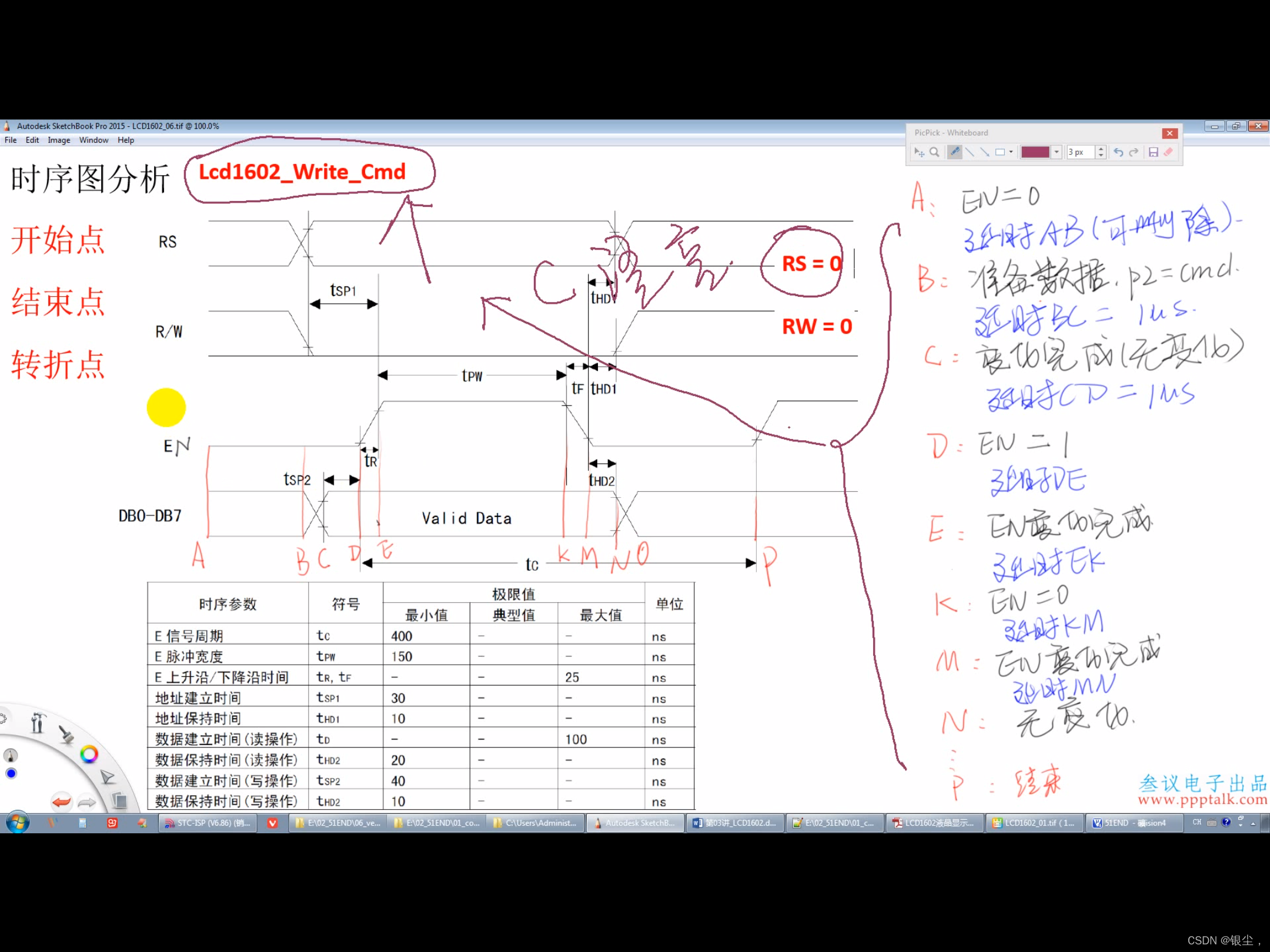
文章目录
00 写在前面
该系列的文章,源自于担任过PIC单片机课程的助教,主要向学弟们讲解了几节实验课的内容。在此记录上课的一些知识。
本系列文章主要介绍的内容:
实验1–介绍和基本I/O–按钮和LED(学习嵌入式的第一步就是点一个灯,就像学习编程语言的第一步都是写一个“hello world”代码)
实验2–MPLAB+PICkit 3+LCD+I/O(这次主要是介绍液晶显示屏的使用,很多时候我们系统的调试都需要用到,比如做一个测温系统,那我们就可以通过液晶显示屏,显示传感器采集的数值,然后再通过软件来做进一步的处理)
实验3–ADC(这个是模数转化实验,就是之前模数电学习那些知识的一个综合运用)
实验4–串行通信–UART
实验5–串行通信–I2C
实验6–计时器和中断(这一部分也是很重要的知识点,在很多的嵌入式系统中都会用到,比如用单片机再加几个传感器就可以搭出智能车,智能车就会用到计时器、中断这些内容)
01 LCD有什么用途
这次主要是介绍液晶显示屏的使用,很多时候我们系统的调试都需要用到,比如做一个测温系统,那我们就可以通过液晶显示屏,显示传感器采集的数值,然后再通过软件来做进一步的处理。
02 我们直接根据LCD demo 这个代码来讲一下LCD的原理以及操作?
//
/**
* Title: LCD DEMO for use in Lab 2 tutorial
* C File lcddemo.c
* Platform: PICmicro PIC16F877A @ 4 Mhz
* Written by: GBM
*
* Date: 01/10/2018
*
* Function: A sample c file to show how to use the LCD display onboard
* the PIC DIP-40 board.
*
*/
// CONFIG
#pragma config FOSC = XT // Oscillator Selection bits (XT oscillator)
#pragma config WDTE = OFF // Watchdog Timer Enable bit (WDT disabled)
#pragma config PWRTE = OFF // Power-up Timer Enable bit (PWRT disabled)
#pragma config BOREN = OFF // Brown-out Reset Enable bit (BOR disabled)
#pragma config LVP = OFF // Low-Voltage (Single-Supply) In-Circuit Serial Programming Enable bit (RB3 is digital I/O, HV on MCLR must be used for programming)
#pragma config CPD = OFF // Data EEPROM Memory Code Protection bit (Data EEPROM code protection off)
#pragma config WRT = OFF // Flash Program Memory Write Enable bits (Write protection off; all program memory may be written to by EECON control)
#pragma config CP = OFF // Flash Program Memory Code Protection bit (Code protection off)
// #pragma config statements should precede project file includes.
// Use project enums instead of #define for ON and OFF.
#include <xc.h>
#include <stdio.h> // Include Standard I/O header file
#include "ee302lcd.h" // Include LCD header file. This file must be in same
// directory as source main source file.
#ifndef _XTAL_FREQ
// Unless already defined assume 4MHz system frequency
// This definition is required to calibrate the delay functions, __delay_us() and __delay_ms()
#define _XTAL_FREQ 4000000
#endif
// Definitions____________________________________________________________
#define CLOSED 0 // Define switch action "Closed" as 0
#define SW1 RB0 // Assign Label SW1 to PortB bit 0 (RB0)
#define SW2 RB1 // Assign Label SW2 to PortB bit 1 (RB1)
#define VALUE1 123
#define VALUE2 456
// globals _____________________________________________________
unsigned char gOutString[16]; //
// Prototypes_____________________________________________________________
void setup(void); // Declare setup function
void loop(void); // Declare loop function
void data2LCD(void); // Declare data to LCD function
void lcdTitle(void); // Declare title to LCD function
void clear_outString(void); // Declare outString clear function
//Main program
void main(void)
{
setup(); // Call initialisation
lcdTitle(); // Call LCDTitle
//Superloop
for(;;)
{
loop(); // Write data to LCD
}
}
void setup(void)
{
Lcd8_Init(); // Required initialisation of LCD to 8-bit mode
TRISB=0x03; // Set PORTB bit 0 and 1 as inputs
}
void loop(void)
{
data2LCD();
}
void data2LCD(void)
{
if (SW1 == CLOSED) // If SW1 closed then
{
Lcd8_Clear(); //clear LCD display
clear_outString(); //clear outString array
sprintf(gOutString,"Int Value1 is"); //define string as "Int Value is"
Lcd8_Write_String(gOutString); //print string to LCD
Lcd8_Set_Cursor(2,1); //select line 2 of LCD
sprintf(gOutString," %d",VALUE1); //define intvalue as a char in outString
Lcd8_Write_String(gOutString); //print string to LCD
}
if (SW2 == CLOSED) // If SW2 closed then
{
// Modulus used to help convert integer to ASCII character
Lcd8_Clear(); //clear LCD display
clear_outString(); //clear outString array
sprintf(gOutString,"Int Value2 is"); //define string as "Int Value is"
Lcd8_Write_String(gOutString); //print string to LCD
Lcd8_Set_Cursor(2,7); //select line 2 of LCD
clear_outString(); //clear outString array
gOutString[0] = (VALUE2/100)%10 + 48; // add 48 (0x30) to remainder to offset to character in Ascii table.
gOutString[1] = (VALUE2/10)%10 + 48;
gOutString[2] = (VALUE2/1)%10 + 48;
Lcd8_Write_String(gOutString);
}
}
void lcdTitle(void)
{
Lcd8_Write_String("LCD demo"); // print "LCD Demo" on line 1 of LCD
Lcd8_Set_Cursor(2,1); // select line 2
Lcd8_Write_String("LCD demo"); // print "LCD Demo" on line 2 of LCD
}
void clear_outString(void)
{
int i;
for (i=0; i<16; i++)
{
gOutString[i] = 0x00;
}
}
首先就是要对压缩包进行解压,然后就可以看到有两个文件,一个是.c另一个是.h,这两个文件都要包含进入项目中,然后再编译就不会有问题。接着按我们第一个实验的操作,把它下载进入PIC单片机中,就可以看到LCD上两行都亮lcd demo。
那接下来的重点就是给大家,讲解一下代码如何来理解,理解完了之后,你们就会对lcd进行操作了。
首先,前面这些跟之前实验一样,接着就进入到main函数中。进入main函数之后,就是setup函数,setup函数中包含初始化函数,初始化函数就是设置相关寄存器。
首先看一下原理图,包含RE(主要是控制信号)、RD(主要是数据口)、电源端口
所以我们寄存器就设置TRISD、TRISE;
接着再看一下原理图我们会发现,RE端口是跟几个模拟信号的引脚复用,而我们需要的是数字信号,所以我们肯定要设置某一个寄存器。这个寄存器是ADCON1(可以通过芯片手册查看),然后只要AN5–AN7是数字信号就可以。
所以,我们总共设置TRISD、TRISE、ADCON1三个寄存器;

Lcd8_Port这个函数的功能就是用来给RD引脚赋值,就是进行一些与运算,将16进制转化成为2进制的八位数就是PORTD八个引脚的值。(也就是传给LCD的数据;)
03 时序
(这里给大家强调一个点:单片机就是设置寄存器,然后它就可以有相应的功能;那今天我们开始讲外设,就是除了单片机之外的其他模块,比如今天的LCD;那外设通常都包含有芯片(比如LCD、IIC通信等等),那对芯片的操作就是写相应的时序。)
比如LCD有下面这四个基本时序:(今天用到写指令、写数据)

如何读懂时序?
https://blog.csdn.net/special00/article/details/80928684



04 显示相关



05 结尾

大家记得点赞收藏!!!























 4241
4241

 被折叠的 条评论
为什么被折叠?
被折叠的 条评论
为什么被折叠?








